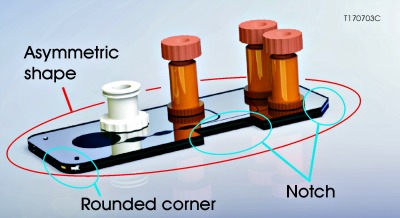Most microfluidic chips have a rectangular body, but this doesn’t have to be the case. While a chip with rectangular shape might be relatively easy to fabricate, and at first may appear to be the cheaper fabrication option, there are other considerations that could make an alternate geometry a more cost-effective long-term solution, even if the chip itself is initially slightly pricier.
Here are some application-related design elements you may want to consider:
- Ease of Use: Making the body clearly asymmetric will help the users recognize immediately if the part is positioned correctly or if it needs to be flipped or rotated. This is especially useful with transparent parts such as microfluidic chips.
- Extended Lifetime: Rounding the corners of the substrate should reduce the probability that the part will be accidentally chipped during routine handling. Even radii as small as 1-mm may extend the operational life of your device.
- Ease of Handling: Notching the substrate, or adding through-holes for alignment pins, can be used to simplify the positioning of the chip in a fixture or an instrument. (Our manufacturing precision is equal or better than what a typical CNC metal workstation will produce!)
Outside Shape – Some Manufacturing Limitations (not necessarily casted in concrete)
Minimum size: big enough to handle (~ 1 cm2), big enough to allow for connectors (should you want some)
Maximum size: Up to 4” x 4” (Number of layers may impact maximum size)
Standard substrate thickness: 0.25, 0.5, 1 mm, or 2 mm. Thinner substrates available upon request
Tolerances: Outside shape (width, length) ± 50 micron. Higher accuracy available if requested (function of design)

